Three-dimensional MOF-derived Co and N co-doped porous carbon bifunctional catalyst for the Zn–air battery†
Abstract
Considering their actual commercial large-scale applications, research on non-precious metal catalysts has garnered much interest. Particularly, metal–organic frameworks (MOFs) are used as non-precious metal catalysts because of their controllable, high surface area and rich N content. Herein, a MOF is transformed into a three-dimensional and porous Co–N–C catalyst by a one-step synthesis method and the joint action of Zn and PVP is reported. The catalyst exhibited efficient oxygen reduction reaction (ORR) performance (E1/2 = 0.83 V vs. RHE) and oxygen evolution reaction (OER) performance (Ej10 = 1.69 V vs. RHE). More meaningfully, the Zn–air battery (ZAB) assembled with the catalyst, exhibited superior 3100 min cycling charging/discharging stability and a high power density of 109.8 mW cm−2, compared with the Pt–RuO2 of 2600 min of cycling charging/discharging stability and power density of 96.1 mW cm−2. The solid-state ZAB based on the catalyst also showed excellent rechargeable flexibility and stability. Undoubtedly, this is a bifunctional oxygen electrocatalytic catalyst with practical application value.

- This article is part of the themed collection: Nanomaterials


 Please wait while we load your content...
Please wait while we load your content...